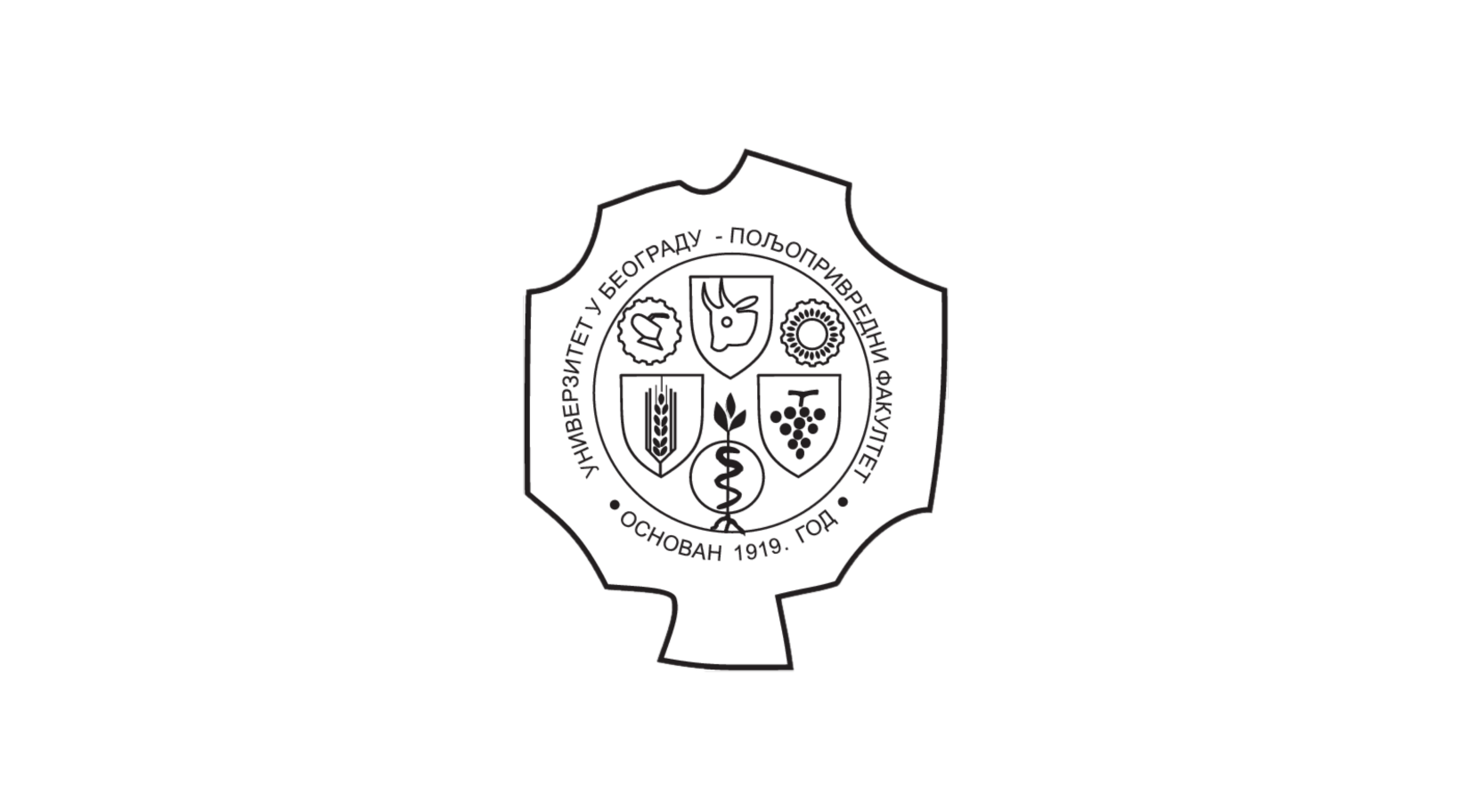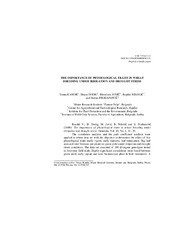The importance of physiological traits in wheat breeding under irrigation and drought stress
Značaj fizioloških svojstava u selekciji pšenice u uslovima navodnjavanja i stresa suše
Апстракт
The correlation analysis and the path coefficient analysis were applied to wheat data set with the objective to determine the effect of five physiological traits (early vigor, early maturity, leaf senescence, flag leaf area and total biomass per plant) on grain yield under irrigation and drought stress conditions. The data set consisted of 100 divergent genotypes tested in four-year field trials. Highly significant correlations were found between grain yield, early vigor and total biomass per plant in both treatments. A highly negative correlation was detected between grain yield and days to flowering, as well as, between grain yield and leaf senescence in both treatments. The path analysis revealed a highly significant direct effect of days to anthesis and total biomass per plant on grain yield. Early vigor, leaf senescence and the flag leaf area had a significant indirect effect on grain yield via days to anthesis and total biomass per plant. Early vigor, early maturity and leaf sene...scence were found to be suitable for wheat breeding under different moisture regimes. These traits can be evaluated quickly and easily, and thus they can be used for the evaluation of large populations.
Korelaciona i path analiza korišćene su da bi se otkrio utacaj pet fizioloških osobina (rani, vigor, ranostasnost, žućenje listova, površina lista zastavičara i ukupna biomasa po biljci) na prinos pšenice u uslovima navodnjavanja i suše. Ispitivano je 100 različitih genotipova u četvorogodišnjim poljskim ogledima. Značajna i pozitivna korelacija utvrđena je između prinosa, ranog vigora i ukupne biomase u oba tretmana. Između prinosa i broja dana do cvetanja, kao i između prinosa i žućenja listova ustanovljena je značajna negativna korelacija u oba tretmana. Path analizom je utvrđeno da je uticaj ranostasnosti i ukupne biomase na prinos bio direktan i značajan. Rani vigor, žućenje listova i površina lista zastavičara su pokazali značajan indirektni uticaj na prinos preko ranostasnosti i ukupne biomase po biljci. Rani vigor, ranostasnost i žućenje listova se mogu smatrati kao pogodni kriterijumi za selekciju u različitim režimima vlažnosti. Ocenjivanje ovih osobina je brzo i lako, pa se ...mogu koristiti u radu sa velikim brojem populacija.
Кључне речи:
correlation analysis / grain yield / path analysis / physiological traits / wheatИзвор:
Genetika, 2009, 41, 1, 11-20Издавач:
- Društvo genetičara Srbije, Beograd
Институција/група
Poljoprivredni fakultetTY - JOUR AU - Kandić, Vesna AU - Dodig, Dejan AU - Jović, Miroslava AU - Nikolić, Bogdan AU - Prodanović, Slaven PY - 2009 UR - http://aspace.agrif.bg.ac.rs/handle/123456789/2004 AB - The correlation analysis and the path coefficient analysis were applied to wheat data set with the objective to determine the effect of five physiological traits (early vigor, early maturity, leaf senescence, flag leaf area and total biomass per plant) on grain yield under irrigation and drought stress conditions. The data set consisted of 100 divergent genotypes tested in four-year field trials. Highly significant correlations were found between grain yield, early vigor and total biomass per plant in both treatments. A highly negative correlation was detected between grain yield and days to flowering, as well as, between grain yield and leaf senescence in both treatments. The path analysis revealed a highly significant direct effect of days to anthesis and total biomass per plant on grain yield. Early vigor, leaf senescence and the flag leaf area had a significant indirect effect on grain yield via days to anthesis and total biomass per plant. Early vigor, early maturity and leaf senescence were found to be suitable for wheat breeding under different moisture regimes. These traits can be evaluated quickly and easily, and thus they can be used for the evaluation of large populations. AB - Korelaciona i path analiza korišćene su da bi se otkrio utacaj pet fizioloških osobina (rani, vigor, ranostasnost, žućenje listova, površina lista zastavičara i ukupna biomasa po biljci) na prinos pšenice u uslovima navodnjavanja i suše. Ispitivano je 100 različitih genotipova u četvorogodišnjim poljskim ogledima. Značajna i pozitivna korelacija utvrđena je između prinosa, ranog vigora i ukupne biomase u oba tretmana. Između prinosa i broja dana do cvetanja, kao i između prinosa i žućenja listova ustanovljena je značajna negativna korelacija u oba tretmana. Path analizom je utvrđeno da je uticaj ranostasnosti i ukupne biomase na prinos bio direktan i značajan. Rani vigor, žućenje listova i površina lista zastavičara su pokazali značajan indirektni uticaj na prinos preko ranostasnosti i ukupne biomase po biljci. Rani vigor, ranostasnost i žućenje listova se mogu smatrati kao pogodni kriterijumi za selekciju u različitim režimima vlažnosti. Ocenjivanje ovih osobina je brzo i lako, pa se mogu koristiti u radu sa velikim brojem populacija. PB - Društvo genetičara Srbije, Beograd T2 - Genetika T1 - The importance of physiological traits in wheat breeding under irrigation and drought stress T1 - Značaj fizioloških svojstava u selekciji pšenice u uslovima navodnjavanja i stresa suše EP - 20 IS - 1 SP - 11 VL - 41 DO - 10.2298/GENSR0901011K ER -
@article{
author = "Kandić, Vesna and Dodig, Dejan and Jović, Miroslava and Nikolić, Bogdan and Prodanović, Slaven",
year = "2009",
abstract = "The correlation analysis and the path coefficient analysis were applied to wheat data set with the objective to determine the effect of five physiological traits (early vigor, early maturity, leaf senescence, flag leaf area and total biomass per plant) on grain yield under irrigation and drought stress conditions. The data set consisted of 100 divergent genotypes tested in four-year field trials. Highly significant correlations were found between grain yield, early vigor and total biomass per plant in both treatments. A highly negative correlation was detected between grain yield and days to flowering, as well as, between grain yield and leaf senescence in both treatments. The path analysis revealed a highly significant direct effect of days to anthesis and total biomass per plant on grain yield. Early vigor, leaf senescence and the flag leaf area had a significant indirect effect on grain yield via days to anthesis and total biomass per plant. Early vigor, early maturity and leaf senescence were found to be suitable for wheat breeding under different moisture regimes. These traits can be evaluated quickly and easily, and thus they can be used for the evaluation of large populations., Korelaciona i path analiza korišćene su da bi se otkrio utacaj pet fizioloških osobina (rani, vigor, ranostasnost, žućenje listova, površina lista zastavičara i ukupna biomasa po biljci) na prinos pšenice u uslovima navodnjavanja i suše. Ispitivano je 100 različitih genotipova u četvorogodišnjim poljskim ogledima. Značajna i pozitivna korelacija utvrđena je između prinosa, ranog vigora i ukupne biomase u oba tretmana. Između prinosa i broja dana do cvetanja, kao i između prinosa i žućenja listova ustanovljena je značajna negativna korelacija u oba tretmana. Path analizom je utvrđeno da je uticaj ranostasnosti i ukupne biomase na prinos bio direktan i značajan. Rani vigor, žućenje listova i površina lista zastavičara su pokazali značajan indirektni uticaj na prinos preko ranostasnosti i ukupne biomase po biljci. Rani vigor, ranostasnost i žućenje listova se mogu smatrati kao pogodni kriterijumi za selekciju u različitim režimima vlažnosti. Ocenjivanje ovih osobina je brzo i lako, pa se mogu koristiti u radu sa velikim brojem populacija.",
publisher = "Društvo genetičara Srbije, Beograd",
journal = "Genetika",
title = "The importance of physiological traits in wheat breeding under irrigation and drought stress, Značaj fizioloških svojstava u selekciji pšenice u uslovima navodnjavanja i stresa suše",
pages = "20-11",
number = "1",
volume = "41",
doi = "10.2298/GENSR0901011K"
}
Kandić, V., Dodig, D., Jović, M., Nikolić, B.,& Prodanović, S.. (2009). The importance of physiological traits in wheat breeding under irrigation and drought stress. in Genetika Društvo genetičara Srbije, Beograd., 41(1), 11-20. https://doi.org/10.2298/GENSR0901011K
Kandić V, Dodig D, Jović M, Nikolić B, Prodanović S. The importance of physiological traits in wheat breeding under irrigation and drought stress. in Genetika. 2009;41(1):11-20. doi:10.2298/GENSR0901011K .
Kandić, Vesna, Dodig, Dejan, Jović, Miroslava, Nikolić, Bogdan, Prodanović, Slaven, "The importance of physiological traits in wheat breeding under irrigation and drought stress" in Genetika, 41, no. 1 (2009):11-20, https://doi.org/10.2298/GENSR0901011K . .




